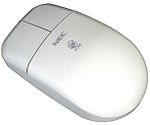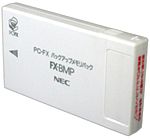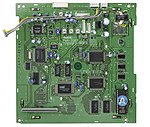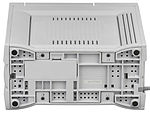PC-FX
This article needs additional citations for verification. (December 2007) |
 The PC-FX console | |
| Manufacturer | NEC Home Electronics |
|---|---|
| Type | Home video game console |
| Generation | Fifth generation era |
| Release date |
|
| Lifespan | 1994–1998 |
| Discontinued |
|
| Units sold | 400.000[1] |
| Media | CD-ROM |
| CPU | NEC V810 |
| Predecessor | PC Engine SuperGrafx TurboDuo |
The PC-FX (ピーシー エフエックス, Pī Shī Efu Ekkusu) is a 32-bit home video game console made by NEC Home Electronics. It was released in Japan on December 23, 1994, just weeks after Sony's PlayStation and a month after the Sega Saturn. It is the successor to the PC Engine, known as TurboGrafx-16 in North America.
Unlike its predecessor, the PC-FX was only released in Japan. The console is shaped like a tower PC and was meant to be similarly upgradeable. However the PC-FX lacked a 3D polygon-based graphics chip which rendered the system underpowered in comparison to its competitors. It was also expensive and lacked developer support, and as a result it was unable to compete effectively with its fifth generation peers. The PC-FX was NEC's last home video game console, and was discontinued in February 1998.
History
NEC launched the PC-FX as the successor to its well received 4th generation system, the PC-Engine.
The PC-FX was based on a 32-bit system architecture named "Tetsujin" or "Iron Man", developed in-house by NEC. NEC demonstrated Iron Man at a number of trade shows and events during 1992, and by the middle of the year were discussing an imminent release of an Iron Man-based video game system with many third party developers. At the time, the earlier PC Engine was still quite popular in Japan, and opinions on the Iron Man technology were mixed. Many were uninterested in switching to more powerful hardware while the PC Engine market was still growing, and as a result NEC halted work on the Iron Man project, instead opting for more modifications to the PC Engine technology.[citation needed]
When NEC decided to release the PC-FX, the specs were relatively unchanged from the originally unveiled Iron Man architecture. The most significant difference was the addition of a new 32-bit V-810 RISC CPU.[2]
The console was announced in late 1993.[2][3] In a special Game Machine Cross Review in May 1995, Famicom Tsūshin would score the PC-FX console an 18 out of 40.[4]
Unusual for a fifth generation console, the PC-FX does not have a polygon graphics processor.[5][6] NEC's reasoning for this was that polygon processors of the time were relatively low-powered, resulting in figures having a blocky appearance, and that it would be better for games to use pre-rendered polygon graphics instead.[7] The shining quality of the PC-FX was the ability to decompress 30 JPEG pictures per second while playing digitally recorded audio (essentially a form of Motion JPEG).[6][7] This resulted in the PC-FX having superior full motion video quality over all other fifth generation consoles.
 |
 |
 |
The system's target audience was roughly five years older than that of the PC Engine, in hopes that PC Engine fans would be brought over to the successor console.[7] In an interview roughly a year before the system launch, a representative stated that though NEC had not entirely ruled out the possibility of a release outside Japan, they had concluded that unless additional non-gaming uses were developed for the PC-FX, it would sell poorly in the USA due to its high price.[7]
NEC directed Hudson Soft, with whom they continued their partnership over the PC Engine, to develop only games based on popular anime franchises and using prerendered animated footage. Though this policy played to the hardware's strengths, it barred Hudson Soft from bringing successful PC Engine series such as Bomberman and Bonk to the PC-FX.[8]
Unlike nearly any other console (except for the 3DO and CD-i), the PC-FX was also available as an internal PC card for NEC PC-98 and AT/IBM PC compatibles. This PC card came with two CDs of software to help the user program games for the PC-FX. However, compatibility issues prevented games developed with this software from actually running on the console.
The PC-FX was discontinued in early 1998. It sold only 400,000 units over its lifetime.[9]
Hardware
 |
 |
 |
The PC-FX uses CD-ROMs as its storage medium, following on from the expansion released for its predecessor, which originally used HuCards. The game controller is virtually identical to a DUO-RX controller, but the rapid fire switches have been replaced with mode A/B switches. Peripherals include a PC-FX mouse, which is supported by strategy games like Farland Story FX and Power DoLLS FX.
The PC-FX's computer-like design was unusual for consoles at the time. It stands upright like a tower computer while other contemporary consoles lay flat. Another interesting feature is its three expansion ports. Also, similar to the 3DO, it featured a built in power supply.
The PC-FX includes an HU 62 series 32-bit system board, an LSI chip, and a 32-bit V-810 RISC CPU. The system can display 16.77 million colors (the same amount as the PlayStation).[2]
Software
There were 62 games released for the system. The launch titles were Graduation 2: Neo Generation FX, Battle Heat and Team Innocent on December 23, 1994 and the final game released was First Kiss Story on April 24, 1998. The system and all titles were only released in Japan. A number of demo discs were also released with publications which allowed the user to play the disc in a CD equipped PC-Engine or the PC-FX.
There was no copy protection on any of the PC-FX games, because at the time the system was released, the high price of CD-R drives made piracy expensive.
The system is known for having a high percentage of adult video games.[10]
Technical specifications
 |
 |
 |
- CPU
- 32-Bit NEC V810 RISC running at 21.5 MHz, 15.5 MIPS
- CD-ROM Drive
- 2X CD-ROM, 300KB / Sec
- Memory
- 2 MB main RAM
- 1 MB shared RAM (for background generators, CD-ROM DMA, motion decoder, and ADPCM)
- 256 KB dedicated VRAM (for HuC6270 chips)
- 1 MB OS ROM
- 256 KB CD Buffer
- 32 KB back-up RAM
- Video
- Internal color format: Digitized Y'UV (not YCbCr)
- Maximum On-screen colors: 16,777,216 (24-bit color, 8 bits per channel)
- Resolutions: 256x240p, 341x240p, 256x480i, 341x480i
- 6 background layers
- 2 sprite layers
- 1 motion decoder layer generated from RLE-encoded or JPEG-like data
- Video out: Composite and S-Video
- Sound
- 16-Bit Stereo CD-DA
2 ADPCM channels at up to ~31.5 kHz with left/right panning
6 5-bit sample channels with left/right panning - Audio out: × 2 RCA
- Expansion Ports
- SCSI IO Expansion Slot x 1(Rear), Backup RAM - FX-BMP Card Slot x 1 (Front), 3D VPU Expansion Slot x 1 (Bottom)
- Input Devices
- FX-PAD - 6 Button, 2 Switch(software-handled) Gamepad Controller, FX-MOU - 2 Button Mouse
- Accessories
- FX-BMP - 128KB+ Backup RAM Card with x 2 AAA batteries, FX-SCSI - Adaptor allows a PC to use the PC-FX as a 2X SCSI CD-ROM
References
- ^ Game Data Library, Total Hardware Results [1]. July 2016
- ^ a b c "NEC of Japan Reveals Specs on New FX 32-Bit Game System!". Electronic Gaming Monthly. No. 54. Sendai Publishing. January 1994. p. 66.
- ^ "Yet One More 32-bit System". GamePro. No. 56. IDG. March 1994. p. 184.
- ^ Game Machine Cross Review: PC-FX. Weekly Famicom Tsūshin. No.335. Pg.167. 12–19 May 1995.
- ^ "Next Wave". Electronic Gaming Monthly. No. 60. Sendai Publishing. July 1994. p. 110.
- ^ a b "Overseas ProSpects: NEC PC-FX". GamePro. No. 64. IDG. November 1994. p. 268.
- ^ a b c d "NEC Launches New PC-FX Game System!". Electronic Gaming Monthly. No. 66. Sendai Publishing. January 1995. pp. 172–173.
- ^ "Hudson Soft". Next Generation. No. 3. Imagine Media. March 1995. p. 81.
- ^ "Hardware Totals". Game Data Library. Retrieved 13 October 2016.
- ^ http://www.giantbomb.com/pc-fx/3045-75/
External links
- Pcenginefx.com - The NEC console resource for the PC Engine, TurboGrafx & PC-FX.
- PC Engine's ambitious replacement - From Next Generation's 1995 premier issue.
